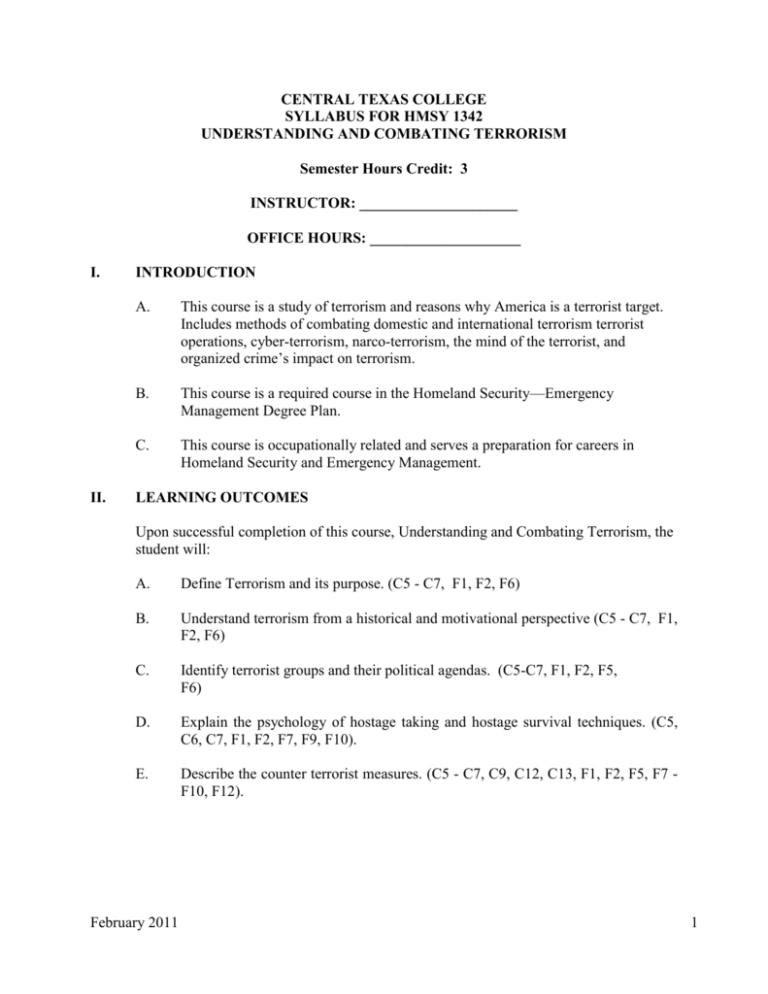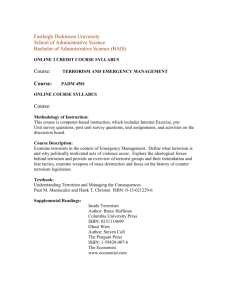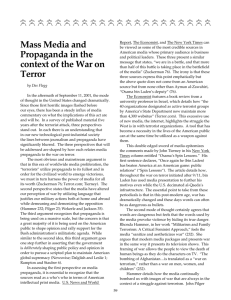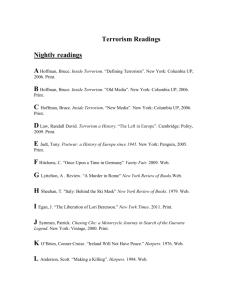CENTRAL TEXAS COLLEGE
advertisement

CENTRAL TEXAS COLLEGE SYLLABUS FOR HMSY 1342 UNDERSTANDING AND COMBATING TERRORISM Semester Hours Credit: 3 INSTRUCTOR: _____________________ OFFICE HOURS: ____________________ I. II. INTRODUCTION A. This course is a study of terrorism and reasons why America is a terrorist target. Includes methods of combating domestic and international terrorism terrorist operations, cyber-terrorism, narco-terrorism, the mind of the terrorist, and organized crime’s impact on terrorism. B. This course is a required course in the Homeland Security—Emergency Management Degree Plan. C. This course is occupationally related and serves a preparation for careers in Homeland Security and Emergency Management. LEARNING OUTCOMES Upon successful completion of this course, Understanding and Combating Terrorism, the student will: A. Define Terrorism and its purpose. (C5 - C7, F1, F2, F6) B. Understand terrorism from a historical and motivational perspective (C5 - C7, F1, F2, F6) C. Identify terrorist groups and their political agendas. (C5-C7, F1, F2, F5, F6) D. Explain the psychology of hostage taking and hostage survival techniques. (C5, C6, C7, F1, F2, F7, F9, F10). E. Describe the counter terrorist measures. (C5 - C7, C9, C12, C13, F1, F2, F5, F7 F10, F12). February 2011 1 III. INSTRUCTIONAL MATERIALS A. B. IV. The instructional materials identified for this course are viewable through www.ctcd.edu/books References: As recommended by the instructor. COURSE REQUIREMENTS A. Class preparation: Students are required to prepare for class in advance according to the schedule presented in the syllabus. Students should read about the next lesson and come to class ready to enhance that knowledge. In-class time should be spent with the instructor to get as much help and to ask as many questions as possible pertaining to the lesson that was already prepared for at home. Students should ask the instructor questions in class, before or after class, during office hours, or by making an appointment. Students are also strongly encouraged to E-mail the instructor if time is of the essence. B. Reading Assignments: Students are required to read the assigned lessons from the text book. There will be a written quiz on each lesson. Vocabulary from each lesson will be used in oral conversation during the class following the assignment. C. Homework: Will be assigned on a regular basis and students are expected to complete it in a timely fashion. The instructor is under no obligation to accept overdue homework assignments. D. Everything submitted to your instructor is graded accordingly and therefore contributes in the outcome of your final grade. E. Class Performance: If a class is missed, it is students’ responsibility to obtain the information missed during the class. The teacher will not repeat instructions or lessons for the classes the student misses. It is the student’s responsibility to make arrangements to take an exam early if he or she will not be able to attend class on one of those days. Failure to notify the instructor will result in a grade of zero on that test/quiz. There are no make-up quizzes. F. Class Participation: The percentage of students grades are based on attendance and participation. The student will practice conversation with a partner during part of each class and will be graded on the effort put into these exercises. G. Good class notes are indispensable for earning a good grade since both the material assigned and discussed will be the basis for examination material. HMSY1342 2 V. VI. EXAMINATIONS A. There will be at least two exams for this course. B. A student must be present for all examinations. No make-up examinations will be given. Students who know in advance they will be absent from an examination due to valid reasons, must arrange to take an early examination if allowed by the instructor. Unexpected absences due to illness or extenuating circumstances require the student to see the instructor about individual make-up work in lieu of the missed examination. One exam maximum per semester may be allowed to be made due to valid reasons. C. Students without excused absences will be given a zero for the examination missed. Quizzes will not be allowed to be made up under any circumstances. SEMESTER GRADE COMPUTATIONS A. Your course grade is determined by your performance on assignments, projects, and exams. B. The possible grades for this course are A, B, C, D, or F. In order to receive transferable for this course, a grade of C or above must be earned. As a rule, D's will not transfer to other colleges. Grading criteria will be based on the http://www.ctcd.cc.tx.us/grades.htm: Grade A B C D F Percent 90-100% 80-89% 70-79% 60-69% 0-59% Points 900-1000 800-899 700-799 600-699 below VII. NOTES AND ADDITIONAL INSTRUCTIONS FROM THE INSTRUCTOR A. Course Withdrawal: There are occasions when it may be necessary to drop a course. In order to be officially withdrawn from the course, a student must obtain and complete a withdrawal form and have it signed thereon. The student's transcript will show "W" or "F", depending on whether the student is passing or failing in his/her course at the time of withdrawal. Friday of 3rd week for Friday of 4th week for Friday of 6th week for Friday of 7th week for Friday of 9th week for Friday of 12th week for HMSY1342 5-week courses 6-week courses 8-week courses 10-week courses 12-week courses 16-week courses 3 The equivalent date (75% of the semester) will be used for sessions of other lengths. The specific last day to withdraw is published each semester in the Schedule Bulletin. Students who officially withdraw will be awarded the grade of "W", provided the student's attendance and academic performance are satisfactory at the time of official withdrawal. Students must file a withdrawal application with the college before they may be considered for withdrawal. A student may not withdraw from a class for which the instructor has previously issued the student a grade of "F" or "FN" for nonattendance. B. An Administrative Withdrawal: An administrative withdrawal may be initiated when the student fails to meet College attendance requirements. The instructor will assign the appropriate grade on the Administrative Withdrawal Form for submission to the registrar. C. An Incomplete Grade: The College catalog states, "An incomplete grade may be given in those cases where the student has completed the majority of the course work but, because of personal illness, death in the immediate family, or military orders, the student is unable to complete the requirements for a course..." Prior approval from the instructor is required before the grade of "I" is recorded. A student who merely fails to show for the final examination will receive a zero for the final and an "F" for the course. D. Cellular Phones and Beepers: Cellular phones and beepers will be turned off while the student is in the classroom or laboratory. E. American’s with Disabilities Act (ADA): Disability Support Services provides services to students who have appropriate documentation of a disability. Students requiring accommodations for class are responsible for contacting the Office of Disability Support Services (DSS) located on the central campus. This service is available to all students, regardless of location. Explore the website at www.ctcd.edu/disability-support for further information. Reasonable accommodations will be given in accordance with the federal and state laws through the DSS office. F. Instructor Discretion: The instructor reserves the right of final decision in course requirements. G. Civility: Individuals are expected to be cognizant of what a constructive educational experience is and respectful of those participating in a learning environment. Failure to do so can result in disciplinary action up to and including expulsion. HMSY1342 4 VIII. COURSE OUTLINE: A. B. HMSY1342 Unit One: Concepts of Terror and Terrorism 1. Learning Outcomes: Upon successful completion of this unit, the student will be able to: a. Explore the definitional problems and terrorism b. Discuss the morality of Terrorism b. Review several typologies and atrocities of terrorism c. Discuss the purposes of terrorism 2. Learning Activities: a. Classroom lecture/discussion (C5, C9, F15) b. Reading assignments. (F1, C1) 3. Lesson Outline: a. Definitional problems and terrorism b. Morality of terrorism c. Definitions of terrorism d. Terrorist typologies e. Terrorist atrocities f. Purpose of Terrorism Unit Two: Historical Antecedents of Terrorism and Violence 1. Learning Outcomes: Upon successful completion of this unit, the student will be able to: a. Identify historical trends of violence and terrorism. b. Trace the relationship between ancient and modern terrorist groups. c. Explore the difference between anarchism and terrorism. d. Survey the historical evidence of violence and terrorism in the United States. e. Develop an insight into the relationship between American value orientation and pervasive violence. 2. Learning Activities: a. Classroom lecture/discussions (C9, C5) b. Reading Assignment (F1) 3. Lesson Outline: a. Sicarii and Zealots b. The assassins and other secret societies c. Narodnaya Volya d. The anarchist tradition e. Terrorism in the United States 5 f. g. h. i. j. C. D. HMSY1342 Puerto Rican Independence The Jewish Defense League The Ideological Left The Ideological Right Single-issue terrorist Unit Three: Violence and Terrorism: The Role of the Mass Media 1. Learning Outcomes: Upon successful completion of this unit, the student will be able to: a. Explore the relationship between television and the escalation of violence in American society. b. Analyze nature of contagion theory. c. Outline historical trends of skyjacking. d. Detail the uses of propaganda by terrorist groups. e. Interpret the use of a hunger strike as a media attention strategy f. Recognize the insidious nature of censorship. g. Evaluate law enforcement and media relations. 2. Learning Activities: a. Classroom lecture/discussions (C9, C5) b. Reading Assignment (F1) 3. Lesson Outline: a. Contagion theory or the copycat syndrome b. Propaganda value and the “Deed” c. United States d. Internet and Terrorism e. Censorship and terrorism Unit Four: The Palestine Question and Al Qaeda 1. Learning Outcomes: Upon successful completion of this unit, the student will be able to: a. Trace the historical antecedents of the Arab—Israeli Conflict. b. Identify extremist groups affiliated with the PLO. c. Compare and contrast the Palestine question and Al Qaeda. d. Discuss the Zionist Movement. e. Explore the escalation of terrorism in democracies. f. Speculate as to the nature of terrorism in the twenty-first century. 2. Learning Activities: a. Classroom lecture/discussions (C9, C5) b. Reading Assignment (F1) 6 3. E. HMSY1342 Lesson Outline: a. Palestine resistance movement b. Historical antecedents c. Palestine liberation organization d. Palestinian extremism and the 1973 Yom Kippur War e. Rejectionist front: Historical preview f. Invasion of Lebanon g. Hizballah h. Palestinian authority i. Hamas and Islamic Jihad j. Al Aqsa Martyrs Brigades k. Al Qaeda Unit Five: Designated Foreign Terrorist Organizations: The “A List” 1. Learning Outcomes: Upon successful completion of this unit, the student will be able to: a. Identify foreign terrorist organizations (FTO’s) that pose a threat to the United States and its allies. b. Understand the objectives of Islamic terrorist groups. c. Review the political ideologies of designated FTOs. d. Describe the influence of al Qaeda on the objectives of the designated FTOs. e. Discuss the criteria for selection as an FTO. f. Compare and contrast national/separatist FTOs and Islamic fundamentalist FTOs. 2. Learning Activities: a. Classroom lecture/discussions (C9, C5) b. Reading Assignment (F1) 3. Lesson Outline: a. Palestinian groups b. The Philippines and Southeast Asia c. Algerian Groups d. Religious Cults e. European Groups f. Colombia g. Peru h. Central Asia i. Iran 7 F. G. HMSY1342 Unit Six: The Dynamics of Hostage Taking and Negotiation 1. Learning Outcomes: Upon successful completion of this unit, the student will be able to: a. Sketch the historical precedents of hostage taking. b. Describe at least three categories of hostage takers. c. Explain the Stockholm Syndrome e. Recognize the need for hostage guidelines. f. Review hostage survival strategies. g. Trace the historical experience of U.S. hostage-taking rescue attempts. h. Describe the Good Guys hostage-taking incident. 2. Learning Activities: a. Classroom lecture/discussions (C9, C5) b. Reading Assignment (F1) 3. Lesson Outline: a. Early history of hostage taking b. Typologies of hostage takers c. Time, Trust, and the Stockholm Syndrome d. London Syndrome e. Guidelines for hostage events f. U.S. experience: hostage rescue g. The Good Guys hostage incident h. Other rescue attempts i. Surviving a hostage situation Unit Seven: Contemporary Terrorism and Bombing 1. Learning Outcomes: Upon successful completion of this unit, the student will be able to: a. Identify the effects of an explosion. b. Explore the historical antecedents of explosive materials. c. Distinguish between low – and high-velocity explosives. d. Describe the phases of blast / pressure. e. Examine several vehicle bomb attack methods. f. Outline a law enforcement strategy to cope with vehicle bombs. g. Explore incidence of aircraft bombings. h. Develop a security program to prevent injuries due to mail bombs. 2. Learning Activities: a. Classroom lecture/discussions (C9, C5) b. Reading Assignment (F1) 8 3. H. I. Unit Eight: Suicide Bombers: A Global Problem 1. Learning Outcomes: Upon successful completion of this unit, the student will be able to: a. Explore the nature of suicide bombing b. Describe the motivation of suicide bombers. c. Identify terrorist groups involved in suicide bombings. d. Understand the complexity of suicide. e. Develop strategies to interdict suicide bombings. f. Speculate as to the future of suicide bombing attacks. 2. Learning Activities: a. Classroom lecture/discussions (C9, C5) b. Reading Assignment (F1) 3. Lesson Outline: a. Defining the problem b. Suicide bombers in the Mideast c. The Iraqi Insurgency d. The Liberation Tigers of Tamil Eelam (LTTE) e. Sikh terrorism f. Kashmiri suicide bombers g. Kurdish suicide bombers: The PKK h. Al Qaeda i. Chechen suicide bombers j. Other suicidal terrorist groups k. Security and Suicide Bombing Unit Nine: Counterterrorist Measures: The Response 1. HMSY1342 Lesson Outline: a. Historical perspective b. Effects of an explosion c. Velocity and Explosives d. Vehicle bombs e. Letter bombs f. Bombings aboard aircraft Learning Outcomes: Upon successful completion of this unit, the student will be able to: a. Understand the major trends in counterterrorist tactics that may have an impact on future policy decisions. b. Differentiate between reactive and proactive counterterrorist strategies. c. Identify steps in the intelligence-gathering process. d. Describe the difficulties in the application of covert operations. 9 e. 2. 3. J. Explain the need for a legal framework that increases the opportunity of prosecution of terrorists. f. Discuss the various strategies for defeating the spread of terrorism, such as the USA Patriot Ace (2001). Learning Activities: a. Classroom lecture/discussions (C9, C5) b. Reading Assignment (F1) Lesson Outline: a. Security measures b. Intelligence function c. Counterterrorist operations: retaliation and preemption d. Covert military operations: Proactive measures e. Counterterrorist operations: Reactive measures f. Special Operations g. United Kingdom and Israel h. National Guard i. HRT and Nest j. Chemical and biological terrorism h. Legal framework: apprehension, prosecution, and punishment i. Emergency Powers j. Post – 9/11 Measures Unit Ten: Future of Terrorism 1. 2. 3. Learning Outcomes: Upon successful completion of this unit, the student will be able to: a. Reexamine the Palestine question. b. Explore the growth of Islamic fundamentalism. c. Discuss the theory of state-sponsored terrorism. d. Describe low-intensity warfare. e. Evaluate the influence of terrorism on the quality of life in the United States. f. Estimate the future of terrorism and political violence. Learning Activities: a. Classroom lecture/discussions (C9, C5) b. Reading Assignment (F1) Lesson Outline: a. Israel versus Palestinian resistance movement b. Islamic extremism c. Low-Intensity warfare d. Superterrorism e. Influence of Terrorism on democracy Other time blocks not specifically allocated above are spent with introductory topics, administrative matters, exams, and review classes (both before and after exams). HMSY1342 10







